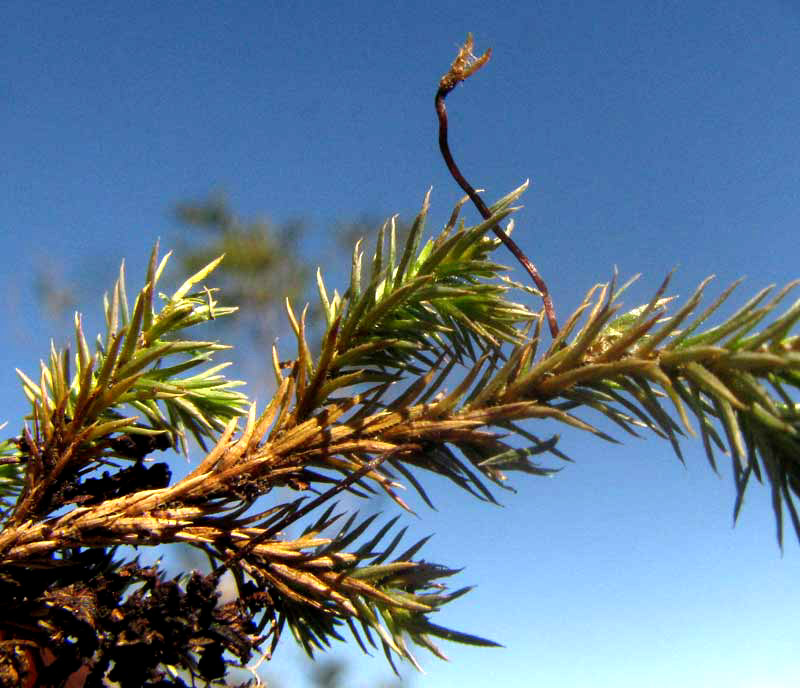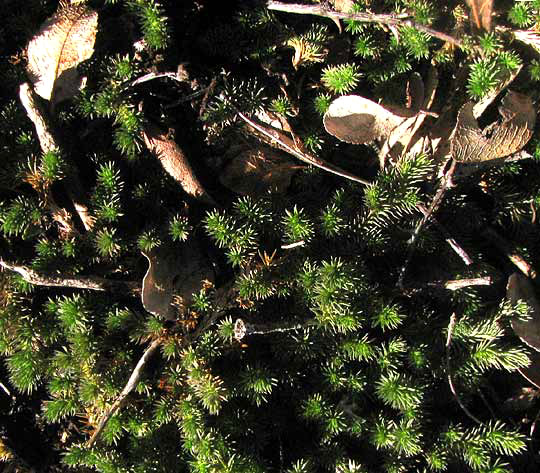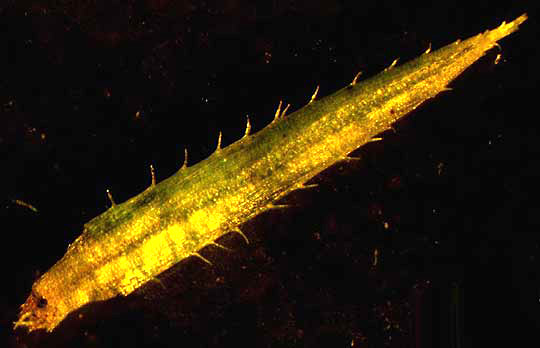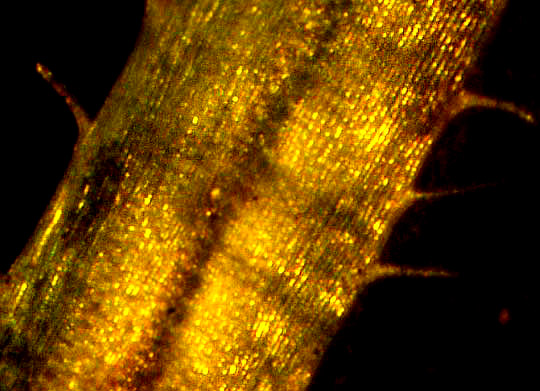Excerpts from Jim Conrad's
Naturalist Newsletter

from the December 29, 2013 Newsletter issued from the Frio Canyon Nature Education Center in the valley of the Dry Frio River in northern Uvalde County, southwestern Texas, on the southern border of the Edwards Plateau; elevation ~1750m (~5750 ft); N29.62°, W99.86°; USA
CONCRETE MOSS
Mosses occur much more frequently in moist environments than dry ones, and it's true that in our arid landscape you seldom see them. Mainly they appear in small patches on ground next to the Dry Frio River, on shaded arroyo banks -- arroyos being streams that flow only during infrequent rains -- and spots beneath power lines that for some reason grass hasn't invaded. All these environments appear to be populated by the same moss species, which I haven't identified because of lack of sporangia, which are the structures in which spores develop. Among mosses, sporangia are as distinctive and necessary for identification as are flowers when naming flowering plants.
This week a cutting-board-size patch of mosses very different from the usual ones turned up on a flat, nearly bare, horizontal layer of hard Edwards Limestone capping our hill. As mosses go, it was a large species, as you can see below, by scaling it against the fallen leaves:

At first I had no hope for identifying the plants because no sporangia were apparent. Even with sporangia, identification is a challenge because about 12,000 moss species are currently recognized. Since mosses reproduce with spores, and spores can be disseminated by the wind, many of those species conceivably could turn up here.
Still, this was the only population of this species I'd seen and its identity could be important. On hands and knees I combed the whole little colony for at least one sporangium or the remains thereof, and I was awarded with what's shown at the top of this page.
Here we have only the remains of a sporangium, which earlier was a baglike capsule perched atop a purple stalk. Now only a shattered, goblet-shaped husk remains, but what's shown helps a lot. The picture shows that the stalk arises not at the stem's tip, as it does on many mosses, but rather along a branching stem. Many moss stems don't branch at all. The sporangium seems to have been longish instead of spherical, and more or less symmetrical, while many species produce distinctly bent, asymmetrical ones. Also very important for identification purposes was that the stem grew horizontally on the limestone surface, with only branch tips directed skyward. Many moss stems strictly grow vertically.
From past experience I knew that even seeing such important field marks, probably I'd need a microscopic look at the leaves, so I plucked a leaf and later got to see the 3.5mm-long (±1/8th-inch) leaf shown below:

As moss leaves go, this 3.5mm-long one is pretty large. Also, few kinds of moss produce leaves with such distinctly spiny margins. Most moss leaf margins bear no spines or teeth at all. This leaf clearly has a midrib, or "costa," while many moss leaves don't. Below, even higher magnification reveals more important details:

There it's shown that cells along the margins' borders are similar to those in the rest of the leaf -- all short, squarish ones -- which is noteworthy because in some species cells along the margin are much elongated. In some species all the cells are longish, and display thinner cell walls. Sometimes cell walls are irregular, as if they'd been jig-sawed, but these are regularly short-rectangular.
Even noting all these details I had no success with the Flora of North America's very technical keys, especially because of the lack of a complete sporangium. However, I had the good luck to find on the Internet a page presented by Texas A&M University at Kingsville listing findings of Dr. Cynthia Galloway's "South Texas Moss Project." There moss taxa for counties in southern Texas are listed, and that includes Uvalde County, which with 28 species has more species listed than any other county in the study area. The lists can be browsed at http://users.tamuk.edu/kfcmg00/research.htm.
So, by comparing our pictures with each of the 28 species in Dr. Galloway's list, by far the best-matching species is PTYCHOMITRIUM SERRATUM, not really known by a common name, though some publications make up the name "Serrate Ptychomitrium Moss," based on the Latin. I think of it as the Concrete Moss, and here's why:
The Flora of North America says that the species occurs in Mexico and the Dominican Republic, and in the US in Texas, Louisiana and South Carolina. A recent paper includes findings in Tennessee, New York and Massachusetts. Normally the species occupies calcareous rock such as limestone, but in sites from Eastern Texas eastward and to the north, most finds have been on concrete -- which basically is manmade, calcareous (calcium-rich) rock. The species appears to be expanding its distribution, then, by accepting its calcium from manmade sources. One author proposes that the range expansion toward the northeast follows prevailing "storm tracks"; winds blow spores from here to concrete areas downwind.